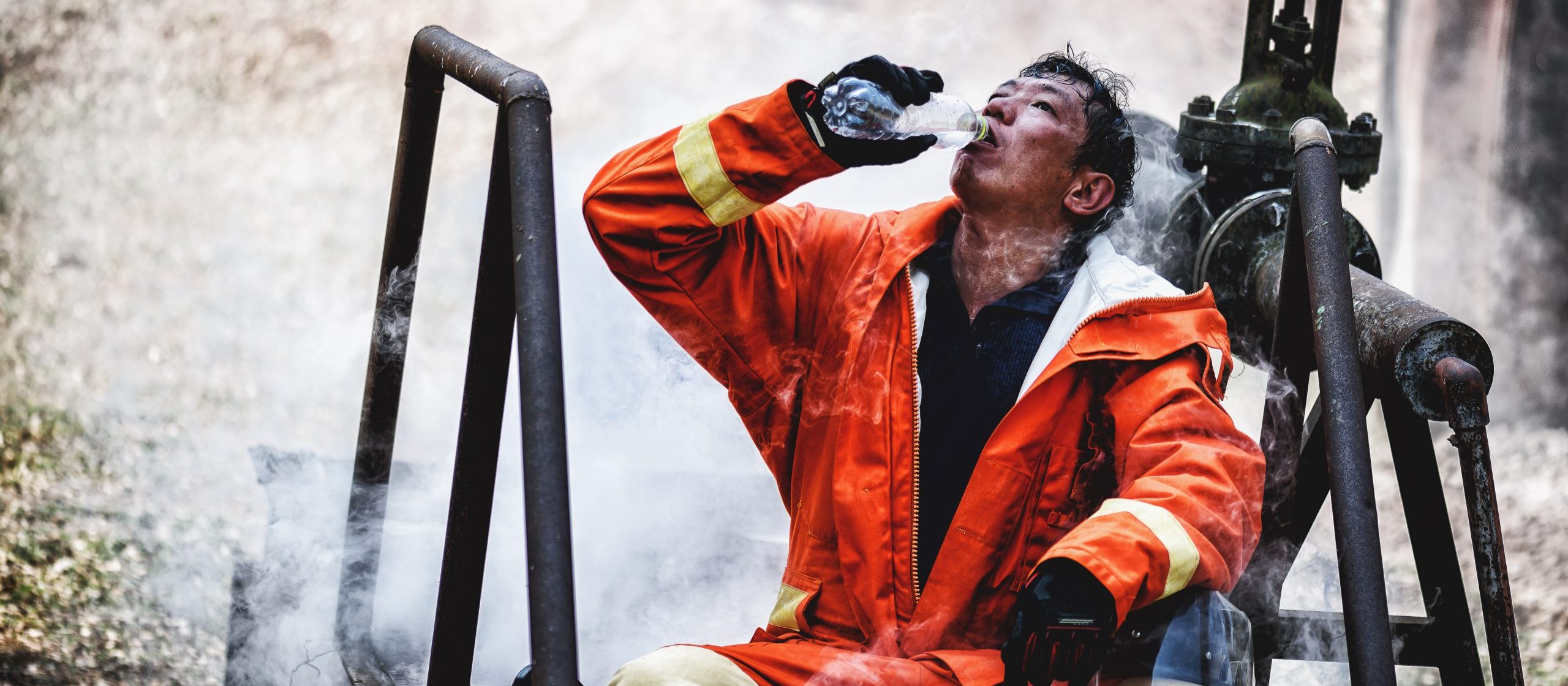Working When the Heat is on: How to Find Your Cool

Many professions and industries will be familiar with the Wet Bulb Globe Temperature (WBGT). Historically and in various organizations today it is used as a measure to determine heat stress; as it represents the thermal environment that an individual is exposed to. While measuring the external environment can highlight the risk of the environment it doesn’t show the actual physiological response of each individual to those conditions.
As with their skill sets, the physiological responses of employees to various workplace stressors will differ. In order to protect your team from the dangers of extreme temperatures it’s important to consider them as individuals. We are all too familiar with the rise in consumer wearables such as smart watches which measure the user’s heart rate; however, the most reliable devices for industrial use have shifted from the wrist to the ear, where all vital signs can be measured, and physiological readings are more accurate for each individual. More advanced solutions, like Bodytrak, provide accurate measures of parameters such as heart rate and core body temperature to indicate incidents like heat stress while the user is working in various environments. The device is comfortably fitted to the user to ensure the insights provided are accurate regardless of their environment as physiological responses can fluctuate even if the environment has not changed.
Consider two employees working in a mill or industrial plant that reaches in excess of 40°C/104°F for an extended period. One member of the team has a high body mass index (BMI), not yet acclimatized, has been exposed to heat-related illness previously and has other health conditions. The other team member is of the same age, however, they are acclimatized and not predisposed to the other health conditions. WBGT would measure the same external temperature for both employees, however, it would not take into account the first employee’s inexperience and predisposed conditions which would impact their physiological response to the heat and higher risk of serious heat illness.
While prevention is the best solution, it is also important to be prepared should physiological thresholds be exceeded. Being alert and armed with the right information to react quickly when a team member is suffering from heat-related illnesses can prevent long term implications. Here our Senior Physiologist, James Davis, takes a look at how our body thermoregulates and how these considerations can help with implementing effective methods to reduce core body temperature (CBT).
Knowledge is power – understand the signs of heat-related illness
Thermoregulating the body
Thermoregulation is how our body maintains its internal core temperature. This is essential for keeping it healthy and functioning correctly. The body tries to maintain CBT in a small window between 36.5°C / 97.7°F and 37.5°C / 99.5°F. When our CBT changes, receptors send messages to the thermoregulatory center in our hypothalamus. In response, it causes changes to blood vessels, skeletal muscles and sweat glands so that heat can be dissipated from the body using the four thermoregulatory mechanisms; radiation, convection, conduction and evaporation. However, this becomes more challenging in higher temperatures. Radiation, convection and conduction all work on a temperature gradient that always transfers heat from the hot environment to the cold environment. These three mechanisms become ineffective when the ambient temperature is greater than the body temperature. In fact, rather than helping the body to lose heat it actually causes the ambient environment to heat the body even further. This increases the reliance on the evaporation of sweat to dissipate heat making it challenging to maintain a normal CBT when working in ambient temperatures that exceed the body temperature.

Knowledge is power – understand the signs of heat-related illness
A high CBT is associated with heat-related illnesses which can impair balance, coordination and cognition, which can increase the chances of an occupational accident occurring and negatively affect productivity. There are also physical changes that individuals may notice as well such as experiencing nausea and an increase in heart rate and respiration. In the most serious cases of heat-illness, when CBT exceeds 40°C/104°F, individuals can suffer from heat stroke where they can have seizures, vomit and if treatment is delayed it can even lead to multiple organ failure and death. Therefore, in the treatment of heat-related illnesses, every second counts. The first point of action should be to contact emergency services immediately. When CBT is extremely elevated, cells begin to die, so fast cooling is vital to thermoregulate the body. This can be achieved through a combination of techniques while waiting for medical support.
Cooling techniques
If the above method is not feasible CBT can also be lowered through convection and conduction by spraying the individual with water and applying ice packs or cold towels over the body while fanning. If the employee is suffering from heat illness it’s important they remove any tight fitting and excess clothing to help reduce CBT. When sweat is trapped in clothing or PPE it cannot evaporate and will not provide a chance for the employee to cool down. In this case they should be removed from the environment and taken to an air-conditioned break room. Some organizations may have specifically designed cooling rooms. While this is an effective course of action it may not always be possible for those working outdoors in isolated areas. Cooling vests are available and designed to be worn underneath PPE to keep the wearer cool and comfortable in warm environments; however, this can also help those who have elevated CBT.
Hydration
According to the Centers for Disease Control and Prevention, daily fluid intake recommendations can vary depending on age, sex, race or ethnicity. When we are exposed to increased temperatures the body sweats as the body’s mechanism to cool itself. When the sweat output exceeds the water intake it leads to dehydration which causes a strain on the cardiovascular system by reducing the amount of blood pumped out of the heart per beat which can lead to a compensatory tachycardia and low blood pressure.
Individuals should be provided with access to plenty of cold fluids so that they can maintain hydration. Excessive sweating removes electrolytes from the body that need to be replaced so drinking isotonic sports drinks as well as water can be extremely beneficial to replace these electrolytes more efficiently. Ensure the team is drinking plenty of fluids throughout the day and not only waiting until they’re thirsty.
Work rotation/scheduling
Working continuously at scorching temperatures is not advisable. NIOSH suggests that using work/rest schedules can significantly reduce the risks of heat-related illness. For example, an employee performing heavy workloads at temperatures of 40°C/104°F should work for 20 minutes and rest for 40 minutes. Taking periodic rest breaks will allow the body to recover and ensure employees are staying hydrated.
Scheduling is a method that can be used to stop heat-related illnesses from becoming more serious; however, accurately and consistently monitoring each individual’s CBT is the most effective preventative measure. As our CBT changes the thermoreceptors in the skin, core and brain send messages to the thermoregulatory center in the hypothalamus. The Bodytrak solution is designed as a comfortable Earpiece making it extremely effective due to its close proximity to blood vessels close to the hypothalamus. Once the data is measured via the in-ear sensors, it is automatically analysed by our proprietary algorithms that are specifically designed for the Bodytrak device. These are sent to both the user (via audio prompts) and supervisor (via the real-time Dashboard) so that intervention can be enabled, and incidents prevented.
When an employee is suffering from heat stress the main priority is to lower the CBT. Knowing the right combination of techniques to implement is critical when every second counts. In most cases heat-related illnesses are completely avoidable if the correct measures are put in place. Physiological monitoring can provide real-time and continuous insights to an individual’s responses to their environment and work stressors. For more techniques to manage heat illness or to learn how you can accurately monitor CBT speak to the Bodytrak team today.




